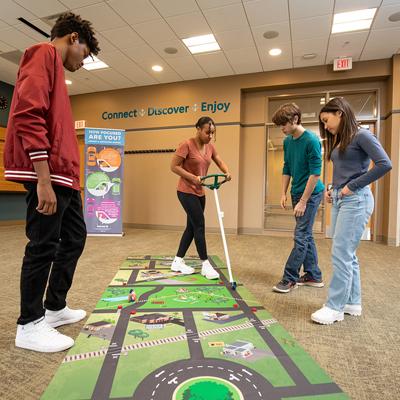Introduce the most effective education program possible with these pointers.
 Starting a distracted driving education program can be a daunting task, but our expert team is here to help.
Starting a distracted driving education program can be a daunting task, but our expert team is here to help.
Young, new drivers can be overconfident, may not understand how serious texting and driving can affect their lives, and may not always be open to hearing adults tell them what to do. In those cases, a well-thought-out and engaging education program can be one of your best tools to help reach this complex audience.
We curated a list of tips to get you started with your distracted driving education program:
- Invest in hands-on, engaging activities
- Incorporate real-world facts and examples into your lessons
- Address new drivers overconfident in their multitasking abilities
- Create a plan to help set realistic goals and rules for driving
- Ask for participant feedback
Read on for more about these tips for starting or revamping your distracted driving education program.
Invest in hands-on, engaging activities
Many people learn best by doing, so in combination with learning statistics and real-world examples, have some activities for the students in your distracted driving education program. Using the Fatal Vision® Drowsy and Distracted Driving Goggles is a great way to teach lessons in a hands-on yet safe way, especially when paired with various activities like the DIES® Distracted Driving Activity Mat, and the Distract-A-Match® Game. You can order a complete Drowsy and Distracted Driving Kit that will work best for your program.
Another great option to teach young drivers or soon-to-be drivers is a driving simulator like the Fatal Vision Roadster Pedal Kart or the Simulated Impaired Driving Experience (SIDNE) Vehicle. For more information on these hands-on teaching tools, check out these reasons to add a distracted driving simulator to your program.
Incorporate real-world facts and examples into your lesson
Informing young drivers about the real-world statistics of distracted driving may help them understand that using their phones while driving can have severe consequences. Use reliable sources like End Distracted Driving to gather facts and information to share with your group. Use statistics that you think will resonate with the age group you are leading.
Address new driver overconfident in their multitasking abilities
Be aware of the overconfidence that a new driver may have in their ability to handle their phone while driving. Many of these young adults in your distracted driving education program may not yet understand the required attention it takes to safely drive a vehicle or just how much can happen when they have their eyes off of the road for “a few seconds.”
New drivers may see driving as a boring, monotonous task that doesn’t require 100% of their attention because they are still learning their abilities. Using hands-on activities and real-world statistics can help illustrate the reality that multitasking while driving is simply unsafe at any time, even for adults who have been driving for years.
Create a plan to help set realistic goals and rules for driving
It is important not to overwhelm young or new drivers with information and rules of what not to do when driving. Helping them set realistic goals and rules while driving is a great way to show that avoiding phone usage while driving is possible.
Here are a few rules you might suggest:
- Put the phone in a spot that is not easily reachable before shifting out of park.
- If the phone is being used for navigation, put the car in park before pulling up the directions.
- Ignore calls and texts while driving – many phones have “Do Not Disturb” settings that make this much easier, and can even automatically send a text reply to someone that you are driving and cannot use the phone at that time.
- Text a parent or guardian before you start driving so, they know not to contact you.
- If there is an emergency, pull over as soon as it is safe to do so, and then use your phone to call for help.
Ask for participant feedback
One of the most important parts of any educational program is to continually assess and improve. If your distracted driving education program targets the same age group year over year, different years and different generations will respond differently to the program. It’s essential to keep up with how students use their phones (like creating social media videos) and address that usage in your program. Asking the participants directly for anonymous feedback can help you understand what went well and what can be improved for the next one.
Young, new drivers are ever-changing in some ways but tend to have the same overconfidence as the young drivers in the generations before them. It’s crucial for educators to stress the importance of safe driving early and often to avoid potentially catastrophic results.
Use these tips and read more about the do’s and don’ts of distracted driving education to get a great start on your distracted driving education program. If you have any questions or would like to incorporate Fatal Vision’s hands-on tools into your distracted driving education program, please contact our team.




 Starting a distracted driving education program can be a daunting task, but our expert team is here to help.
Starting a distracted driving education program can be a daunting task, but our expert team is here to help.